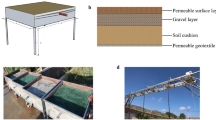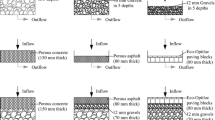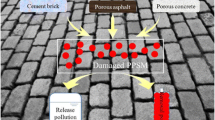Abstract
Permeable pavements with gravel base courses promote infiltration of stormwater and can improve water quality. However, finer grained particles on the surface of the pavements or their surrounding areas may enter the underlying void spaces along with stormwater due to their wash-off behavior and their smaller size. After entry into the void space, the smaller particles can act as a barrier that may reduce the infiltration over time. This can reduce the functionality of the pavement and can alter water quality by either sorbing or leaching chemicals present in the infiltrating stormwater. Factors affecting the particulate deposition in the void spaces include shape and size, hydrophobicity, natural organic matter, metals, and the surface charge of the particulate as well as the media. Red sand particles of three sizes <10, 10–25 and 30–50 μm with crankcase oil and without crankcase oil were mixed with semi-artificial stormwater and passed at a constant flow rate through a glass column containing aggregate with and without being pre-soaked in crankcase oil. This study focused on the resulting transport behavior of particles less than 50 μm in diameter, which were generally not picked up by street sweeping. The results show that the particles with and without oil transported in the column at different scales. The presence of oil in the infiltration media and in the stormwater had a nearly 10 fold higher risk of becoming clogged than when no oil was present. Similarly the calculated serviceable life of pavement was reduced by a similar factor when oil was present.
Similar content being viewed by others
References
Aryal, R. K., Furumai, H., Nakajima, F., and Boller, M. (2005). “Dynamic behavior of fractional suspended solids and particlebound polycyclic aromatic hydrocarbons in highway runoff.” Water Research, Vol. 39, No. 20, pp. 5126–34.
Aryal, R., Baral, B., Vigneswaran, S., Naidu, R., and Loganathan, P. (2011). “Seasonal influence on urban dust PAH profile and toxicity in Sydney, Australia.” Water Science and Technology, Vol. 63, No. 10, pp. 2238–43.
Balades, J. D., Legret, M., and Madiec, H. (1995). “Permeable pavements: Pollution management tools.” Water Science and Technology, Vol. 32, No. 1, pp. 49–56.
Bannerman, R. T., Owens, D., Dodds, R., and Hornewer, N. (1993). “Sources of pollutants in Wisconsin stormwater.” Water Science & Technology, Vol. 28, No. 3, pp. 241–59.
Carlisle, T., Mulamoottil, G., and Mitchell, B. (1991). “Attitudes towards artificial wetlands in ontario for stormwater control and waterfowl habitat.” Water Resources Bulletin, Vol. 27, No. 3, pp. 419–27.
Chebbo, G. and Bachoc, A. (1992). “Characterization of suspended solids in urban wet weather discharges.” Water Science & Technology, Vol. 25, No. 8, pp. 171–9.
Chong, M. N., Sidhu, J., Aryal, R., Tang, J., Gernjak, W., Escher, B., and Toze, S. (2012). “Urban stormwater harvesting and reuse: a probe into the chemical, toxicology and microbiological contaminants in water quality.” Environmental Monitoring and Assessment, Vol. 185, No. 8, pp. 6645–52.
Davis, A. P. (2005). “Green engineering principles promote low-impact development.” Environmental Science and Technology, Vol. 39, No. 16, pp. 338A–44A.
Dunphy, A., Beecham, S., Vigneswaran, S., Ngo, H. H., McLaughlan, R., and Collins, A. (2007). “Development of a confined Water Sensitive Urban Design (WSUD) system using engineered soils.” Journal of Water Science and Technology, 2005, Vol. 55, No. 4, pp. 211–218.
Eriksson, E., Baun, A., Scholes, L., Ledin, A., Ahlman, S., Revitt, M., Noutsopoulos, C., and Mikkelsen, P. S. (2007). “Selected stormwater priority pollutants-a European perspective.” Science of The Total Environment, Vol. 383, No. 1, pp. 41–51.
Ferguson, B. K. (1990). “Role of the long-term water balance in management of stormwater infiltration.” Journal of Environmental Management, Vol. 30, No. 3, pp. 221–233.
Furumai, H., Jinadasa, H. K. P. K., Murakami, M., Nakajima, F., and Aryal, R. K. (2005). “Model description of storage and infiltration functions of infiltration facilities for urban runoff analysis by a distributed model.” Water Science and Technology, Vol. 52, No. 5, pp. 53–60.
Fwa, T., Tan, S., and Guwe, Y. (1999). “Laboratory evaluation of clogging potential of porous asphalt mixtures.” Transportation Research Record: Journal of the Transportation Research Board, Vol. 1681, No. 1, pp. 43–49.
Gerrits, C. and James, W. (2002). “Restoration of infiltration capacity of permeable pavers.” Global Solutions for Urban Drainage, pp. 1–16.
Harding, M. A. (1995). “Improving flood control along the Orleans Avenue Canal.” Aberdeen’s Concrete Construction, Vol. 40, No. 1, pp. 1–4.
Hossain, M. A., Furumai, H., Nakajima, F., and Aryal, R. K. (2007). “Heavy metals speciation in soakaways sediment and evaluation of metal retention properties of surrounding soil.” Water Science & Technology, Vol. 56, No. 11, pp. 81–89.
Israelachvili, J. N. and Pashley, R. M. (1984). “Measurement of the hydrophobic interaction between two hydrophobic surfaces in aqueous electrolyte solutions.” Journal of Colloid and Interface Science, Vol. 98, No. 2, pp. 500–514.
Jayasuriyo, N., Jarrar, A., and Jesse, K. (2006). “Effectiveness of ‘pervious pavements’ in the improvement of surface-water quality.” Water, Vol. 33, No. 3, pp. 62–66.
Kalman, O., Lund, J. R., Lew, D. K., and Larson, D. M. (2000). “Benefitcost analysis of stormwater quality improvements.” Environmental Management, Vol. 26, No. 6, pp. 615–628.
Kazemi, F., Beecham, S., and Gibbs, J. (2009). “Streetscale bioretention basins in Melbourne and their effect on local biodiversity.” Ecological Engineering, Vol. 35, No. 10, pp. 1454–1465.
LeBoutillier, D. W., Kells, J. A., and Putz, G. J. (2000). “Prediction of pollutant load in stormwater runoff from an urban residential area.” Canadian Water Resources Journal, Vol. 25, No. 4, pp. 343–359.
Leung, J. K. Y. (1994). “Flood alleviation by on-site detention.” Transactions Hong Kong Institution of Engineers, Vol. 1, No. 1, pp. 29–35.
Liang, Y., Hilal, N., Langston, P., and Starov, V. (2007). “Interaction forces between colloidal particles in liquid: Theory and experiment.” Advances in Colloid and Interface Science, Vol. 134–135, pp. 151–166.
Liu, W., Chen, W., and Peng, C. (2014). “Assessing the effectiveness of green infrastructures on urban flooding reduction: A community scale study.” Ecological Modelling, Vol. 291, pp. 6–14.
Memon, S., Paule, M. C., Park, S. J., Lee, B. Y., Kang, S., Umer, R., and Lee, C. H. (2013). “Monitoring of land use change impact on stormwater runoff and pollutant loading estimation in Yongin watershed Korea.” Desalination and Water Treatment, Vol. 51, Nos. 19–21, pp. 4088–4096.
Miguntanna, N. P., Liu, A., Egodawatta, P., and Goonetilleke, A. (2013). “Characterising nutrients wash-off for effective urban stormwater treatment design.” Journal of Environmental Management, Vol. 120, pp. 61–67.
Mitchell, G. (2005). “Mapping hazard from urban non-point pollution: A screening model to support sustainable urban drainage planning.” Journal of Environmental Management, Vol. 74, No. 1, pp. 1–9.
Niemczynowicz, J. (1999). “Urban hydrology and water management–present and future challenges.” Urban Water, Vol. 1, No. 1, pp. 1–14.
Pratt, C. J., Mantle, J. D. G., and Scholfield, P. A. (1995). “UK research into the performance of permeable pavement, reservoir structures in controlling stormwater discharge quantity and quality.” Water Science and Technology, Vol. 32, No. 1, pp. 63–69.
Razzaghmanesh, M., Beecham, S., and Kazemi, F. (2014). “Impact of green roofs on stormwater quality in a South Australian urban environment.” Science of The Total Environment, Vol. 470–471, pp. 651–659.
Sansalone, J., Kuang, X., and Ranieri, V. (2008). “Permeable pavement as a hydraulic and filtration interface for urban drainage.” Journal of Irrigation and Drainage Engineering, Vol. 134, No. 5, pp. 666–74.
Seelsaen, N., McLaughlan, R., Moore, S., and Stuetz, R. M. (2007). Influence of compost characteristics on heavy metal sorption from synthetic stormwater, pp. 219–226.
Shackel, B. and Pearson, A. (2005). “Technologies and opportunities for permeable segmental paving in Australia.” Adelaide International Public Works Conference, 2005, Adelaide, South Australia, Australia.
Sidhu, J. P. S., Ahmed, W., Gernjak, W., Aryal, R., McCarthy, D., Palmer, A., Kolotelo, P., and Toze, S. (2013). “Sewage pollution in urban stormwater runoff as evident from the widespread presence of multiple microbial and chemical source tracking markers.” Science of The Total Environment, Vol. 463–464, pp. 488–496.
Soupir, M. L., Mostaghimi, S., and Dillaha, T. (2010). “Attachment of Escherichia coli and Enterococci to Particles in Runoff.” Journal of Environmental Quality, Vol. 39, No. 3, pp. 1019–1027.
Tang, J. Y. M., Aryal, R., Deletic, A., Gernjak, W., Glenn, E., McCarthy, D., and Escher, B. I. (2013). “Toxicity characterization of urban stormwater with bioanalytical tools.” Water Research, Vol. 47, No. 15, pp. 5594–5606.
Travis, M. J., Weisbrod, N., and Gross, A. (2008). “Accumulation of oil and grease in soils irrigated with greywater and their potential role in soil water repellency.” Science of The Total Environment, Vol. 394, No. 1, pp. 68–74.
Turer, D., Maynard, J. B., and Sansalone, J. J. (2001). “Heavy metal contamination in soils of urban highways: Comparison between runoff and soil concentrations at Cincinnati, Ohio.” Water, Air, and Soil Pollution, Vol. 132, Nos. 3–4, pp. 293–314.
Yakubov, G. E., Butt, H.-J., and Vinogradova, O. I. (2000). “Interaction Forces between Hydrophobic Surfaces. Attractive Jump as an Indication of Formation of “Stable” Submicrocavities.” The Journal of Physical Chemistry B, Vol. 104, No. 15, pp. 3407–3410.
Yong, C., McCarthy, D., and Deletic, A. (2012). “Predicting physical clogging of porous and permeable pavements.” Journal of Hydrology, Vol. 481, pp. 48–55.
Yu, B., Jiao, L., Ni, F., and Yang, J. (2014). “Long-term field performance of porous asphalt pavement in China.” Road Materials and Pavement Design, pp. 1–13, (Published online 18 Aug 2014).
Author information
Authors and Affiliations
Corresponding author
Rights and permissions
About this article
Cite this article
Aryal, R., Beecham, S. & Lee, BK. Evaluation of particle transport in permeable pavements under oil loadings. KSCE J Civ Eng 19, 2000–2004 (2015). https://doi.org/10.1007/s12205-015-0046-4
Received:
Revised:
Accepted:
Published:
Issue Date:
DOI: https://doi.org/10.1007/s12205-015-0046-4




